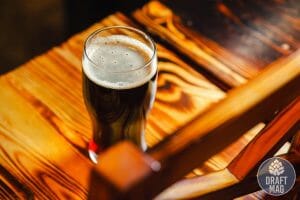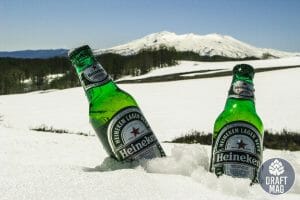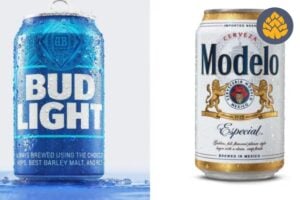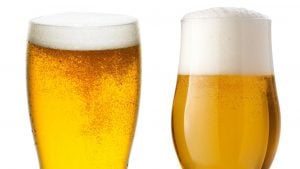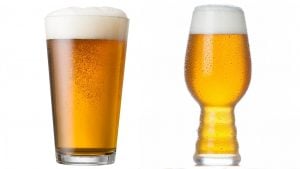Coors Banquet vs Coors Light: Who Wins This Beer Battle
Coors Banquet vs. Coors Light is a question that interests most beer enthusiasts.
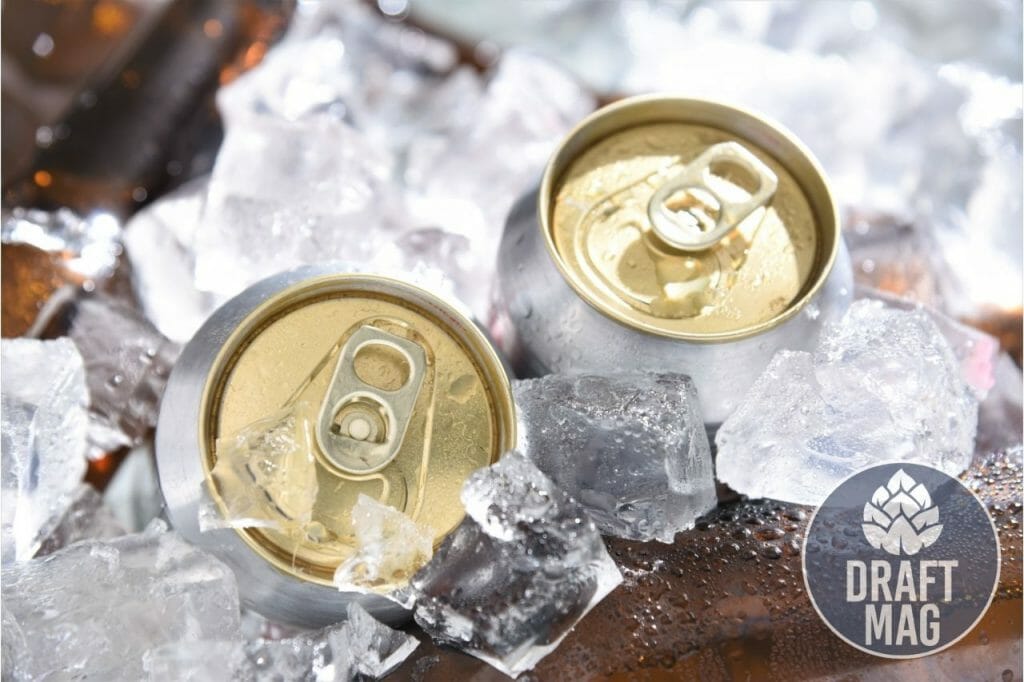
Everyone who has had their fair share of Coors original will agree that the biggest differentiating factor between Coors Banquet and Coors Light lies in their tasting notes such as color, nose, palate, and finish.
However, before we draw a detailed comparison between the two American lagers, let’s learn about the history of the brewing company: its heritage, process, and brewery.
Coors Banquet vs Coors Light: Comparison Table
After a detailed rundown of the different features of both the beers, here is a summary of the differences between the two:
| Parameters | Coors Banquet | Coors Light |
| Origin | 1873 | 1978 |
| Manufactured | Only in Colorado, US | Many countries (eight breweries) |
| Appearance | Sparkling yellow or golden | Straw golden or amber dial |
| Taste/Flavor | Barley flavor with hints of bitterness | Very thin, light flavor. No after taste |
| Smell | Fruity, subtly sweet notes | Wet grass and corn husk aroma |
| Alcohol Content | Five percent | 4.2 percent |
| IBU | 15 | 10 |
| Calorie Content | 147 | 102 |
| Carbohydrates | 11.7gm | 5gm |
| Protein | 1gm | <1gm |
| Food Pairing | cheese sticks, burgers, pizza, spicy wings, beef, cured meats, oily fish, and desserts. | spicy appetizers, BBQ ribs, grilled chicken, and meals such as salads or fish |
What Are the Differences Between Coors Banquet and Coors Light?
The main difference between Coors Banquet and Coors Light is that Coors Banquet is exclusively available in Colorado, US, while Coors Light can be ordered worldwide. Coors Light is a light lager with only 4.2 percent alcohol content, while Coors Banquet is the original Coors beer with five percent.
What Is Coors Banquet Best For?
Coors Banquet is best for cheese sticks, burgers, pizza, spicy wings, beef, cured meats, oily fish, and desserts.
– Features
- Main Ingredient: Water, barley, corn syrup(adjunct) with Hops extracts and yeast.
- Color: The color of this beer is golden with clear clarity. The loosely beaded white foam head dissipates within a couple of minutes, though you may feel the carbonation slightly. Like Coors light, it virtually leaves no body lacing in the glass.
- Nose: A full-bodied Coors banquet pint has a mild aroma of freshly baked bread, fruits, and creamed corn.
- Palate: Subtle sweetness and barley flavor with hints of bitterness (due to hops and yeast) which is undoubtedly refreshing. It gives a delightful, watery, and fizzy mouthfeel. It does hold the ability to be both bitter and sour and has well-balanced flavors and texture. There is a relatively clean, crisp finish.
- Aroma: The beer smells like baked bread with slight undertones of pear and banana.
- ABV: The alcohol content of Coors banquet pint is five percent (U.S.) with an IBU of 15. It is categorized as a light lager.
- Nutrition facts: the one bottle/can (12 ounces) serving size of Coors Banquet contains 147 calories, 11.7 grams of carbs, and one gram of protein.
- Overall experience: Though the Coor banquet may not impress all craft beer lovers, it is still a good beer well-suited for parties or get-togethers. It’s a bit stronger in taste than Coors light, and the sweet flavor of rich creamed corn lingers in your mouth for a bit longer compared to Coors light.
– Coors Banquet: The Banquet Beer
Coors Banquet is referred to as Coors Original lager because of its rich history and is considered the most iconic American lager. Legends say it acquired its name from the crowds of thirsty miners who ordered it en masse and coined the nickname, “The Banquet Beer.”
Coor Banquet is as old as the brewing company. Brewed with 100 percent Rocky Mountain water and Moravian barley cultured by generations of family farmers, the beer is brewed only in one, in the Golden brewery, Colorado. Interestingly, Coors original’s first brewery in Golden, Colorado, is still the largest single brewing facility globally.
-
Brewing Techniques and Branding

Many traditional techniques are still used to produce Coor banquet as the maker believes there’s no sense in changing what works so well. Coors Banquet is brewed in classic Huppmann kettles, fermented in the closed horizontal box, and filtered using Enzinger filters which is a slow, traditional method that requires quality time.
It comes mainly in a retro stubby brown bottle but is also available in cans or cold pint glass.
Unfortunately, Coors Banquets are no longer sold in Canada.
What Is Coors Light Best For?
Coors Light is best for spicy appetizers, BBQ ribs, grilled chicken, and meals such as salads or fish.
– Features
- Main Ingredient: grains along with Hops and Barley
- Color: The coloration is a lovely straw golden or amber dial with a thin foam head that instantly dies with no lacing.
- Nose: A light body pint with clean malt notes. You can smell the wet grass and corn husk aroma with a tint of ethylene.
- Palate: Thin, slightly floral flavor but refreshing. It gives you a feel of drinking a fine corn soda. In other words, if you fill sparkling water with a bit of vinegar in a glass, you can get the idea of its mouthfeel. However, it cannot be both bitter and sour and lacks flavor and texture. There is no after-taste. Some drinkers have also experienced a pleasant grass-like texture in the beer.
- Aroma: The drink smells like grains and corn and is overall unobtrusive. However, if you are drinking it out of a can, chances are you won’t notice any aroma. Also, the taste might be slightly metallic in this case.
- ABV: The alcohol content of Coors light lager is 4.2 percent (U.S.), which is less than the averagely manufactured alcoholic beverage that carries an ABV of 6 percent. In this comparison, it is undoubtedly a healthy light beer. Further, the IBU is only 10, making it a less hoppy beer.
- Nutritional facts: One bottle (12 ounces) of Coor light contains 102 calories per gram. The carbs limit is only five grams. It is vegan-friendly in all forms (except in the U.K.) in the U.S. and other markets. However, the drink is not gluten-free.
- Overall experience: Coors light is a perfect alcoholic beverage with a decent level of carbonation and would probably appeal to those who desire to pull off a classic way of drinking without going for a showy beer.
– Coors Light: The Silver Bullet
Coors Light is also famously called the ‘silver bullet’ because of the beer’s silver-colored iconic can designed by a Cuban-American artist, Marc Barrios. Reviewed as the second largest selling lager in the US, the beer was introduced by Coors brewing company in the 1970s and is considered the world’s most refreshing beer to date.
With 4.2 percent (U.S.) ABV and less hoppy than the original version, Coors Light is a healthy light beer. It can get you drunk, but it will take at least five cans or four bottles to get you tipsy.
-
Branding
The Coors Light is also known for its eye-catching graphics with a cold certification label on the can and its recyclability. The bottle’s wide mouth’s convenience and resealable closure make it further consumeristic. The one outstanding feature of Coors’s light packaged bottle/can is the design of the white mountains on the label that turn to blue whenever the pint’s temperature goes down to four degrees Celsius.
History of Coors American Brewery
Established in 1873, Adolph Coors and Jacob Schuler started Coor American brewery and beer company as “The Golden Brewery” in Colorado. Brewed from Rocky Mountain spring water, the main ingredients of Coors regular lager are a homegrown variety of Moravian barley, a blend of Chinook, Herkules, Hallertau, and Taurus hops and yeast.
The company witnessed many ups and downs, including the historic 13 years national alcohol ban era, recession during the second world war, etc. However, it managed to survive and thrive successfully. Interestingly, Coors was initially termed a regional brand in America as it catered to only Western states. It was also the first brewery in America to present the lagers in environmentally-friendly aluminum beer cans.
– Changes: 1980s to Present
It was only after the mid-80s that the company changed its business strategy and started its nationwide distribution, and finally emerged as the third-largest beer producer in the U.S. As far as its international outreach is concerned, Coors entered the U.K. market first, and then into several other European and Asian countries.
The merger with Canadian brand Molson (in 2005) and SABMiller (in 2007) further strengthened its global network. The brewing company currently enjoys annual sales that constitute about 30 percent of U.S. beer sales.
-
Cold Beer Guarantee
Presently different types of Coors beer are available on the stands: Coor banquet, Coors Light, Coors Edge, Bluemoon, Keystone, Miller, etc. The company offers a unique Cold Beer Guarantee. Moreover, its cans and bottles feature a special thermo ink that turns blue only when cold enough.
The brand is committed to providing high-quality styles of lagers both for the mainstream market and specialty beers segment worldwide. Coors uses a different dilution process to avoid the existence of gluten making in its lagers. Hence it may be set aside as a gluten-free beer to a large extent.
-
Eco-Friendly Beer
Impressively, Coors introduced the idea of recycling to the American public by offering a penny for every can returned to the brewer. In present times all of its breweries are “landfill-free.”
Endnote
Both Coors Banquet and Coors Light are light lagers that may not be soaring your senses high but are appreciably the best ones for beer fans who like to just unwind after a long hard day. Coors Banquet has dominated the American beer industry for decades, whereas Coor light dominates popular public opinion.

Coors Light is the lighter-than-light beer from Coors and can be super refreshing if served very cold on a hot day. The Coor original may be termed the old-age drink compared to Coors light that is far younger and refreshing. However, the Coors banquet is a fuller-bodied American adjunct lager with vibrant characteristics and rich flavors compared to Coors light with a thin, watery flavor profile.
So, all said and done, which one to choose?
The answer is: As You Like It.

